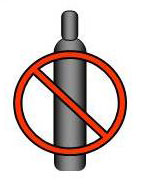Do Not Use Shielding Gas with FCAW-S Electrodes
$name
A: The answer to your first question is no. Not only is the use of any type of shielding gas not necessary for Innershield® NR-212, or any other type of self-shielded, flux-cored electrode (FCAW-S), it should not be used. FCAW-S (i.e. Innershield®) electrodes have a tightly controlled and unique core composition and interaction with the atmosphere (compared to gas-shielded, flux-cored wires). They rely on the oxidizing effect of air to produce the desired weld deposit and desired resulting mechanical properties. When you use a shielding gas, you block the arc from the air and prevent the oxidizing reactions. This results in a much higher level of alloys, such as aluminum, in the weld metal, which produces a brittle and crack sensitive weld deposit. While it is likely that the shielding gas improves the stability and operator appeal of NR-212, it also results in an unacceptable weld deposit.

$name
$name
Regarding your second question about the American Welding Society (AWS) classification of Innershield® NR-212 (E71TG-G), I can see where that would lead to some confusion. While the "G" in FCAW-G stands for gas shielded (or the “S” in FCAW-S for self-shielded), the "G" in a specific electrode AWS classification stands for “general”. Therefore, an E71TG-G classification does not mean that it is a gas-shielded electrode. Typically, a U.S. welding electrode manufacturer (such as Lincoln Electric, etc.) designs an electrode to meet the requirements of a specific, predefined AWS electrode classification, per the appropriate AWS Filler Metal Specification (such as E71T-1, E71T-8, E7018, ER70S-6, etc.). However, a manufacturer is still free to make a particular electrode that does not meet any predefined AWS classification. In these cases, it is classified as "general". Such is the case with Innershield® NR-212, in which the first "G" in the electrode’s AWS number means it has a general usability classification. Innershield® NR-212 also happens to be a low-alloy electrode (i.e. under AWS A5.29 Filler Metal Specification). These electrodes have alloy designations in their suffix (i.e. E71T8-K6, E81T1-K2, E81T1-Ni1, etc.). In the case of Innershield® NR-212, the second “G” is a general alloy suffix classification. Therefore, E71TG-G is its classification.
